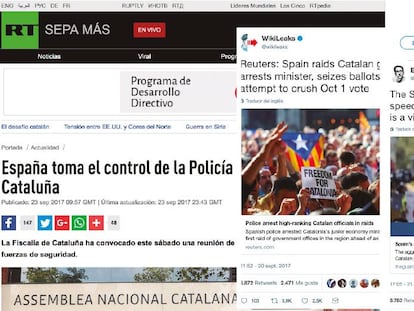No, Catalonia is not being robbed
An analysis of the figures does reveal, however, that the region is slightly underfunded compared to the national average

Does Catalonia get fair fiscal treatment? Is it underfunded? Could the gap between what it pays in taxes and receives in central spending, which the Catalan government puts at €16 billion, morph from a huge deficit into a huge dividend for a newly independent republic?

The debate deliberately mixes concepts relating to the regional financing system, the economic benefits of secession, and the difference between what a region puts in and what it gets back.
The Catalan government has always used fiscal balance data to convey the notion that Catalonia is getting a raw deal.
But the fact is, Catalans are not currently getting fleeced. And an independent Catalonia would not suddenly enjoy a large fiscal surplus.
What is true is that the region is slightly underfunded compared to the national average. It is better off than the Valencia region and Murcia, and on a similar level to Madrid and Andalusia.

Investment in Catalonia could also be improved. Since 1995, investment levels have been below the national average in terms of the region¡¯s GDP and population, though not in terms of its surface area.
Spain has a progressive tax system that means that the richer regions pay more taxes in a bid to redistribute wealth. So Catalonia¡¯s fiscal deficit reflects the fact that it is one of the wealthier regions in Spain.
Investment in Catalonia is beneath what it should be in terms of size and population
Matilde Mas, Valencia University
¡°If we all followed the same logic as the Catalan government, then taxpayers who pay the most taxes should be getting more services from the state than those who pay less,¡± notes Almudena Semur, of the Economic Studies Institute.
The issue, then, is not that a gap exists: it is whether this gap is truly excessive. And comparisons suggest that it is not. The situation in Catalonia is not very different from that of other Spanish or foreign regions with higher-than-average income levels.
In recent years, Madrid and the Balearic Islands have had even bigger fiscal deficits than Catalonia.

¡°There is an inverse relationship between per capita GDP and the fiscal balance,¡± says ?ngel de la Fuente, a renowned expert on the matter whose opinions are valued by the pro-independence movement. ¡°The higher the per capita GDP, the worse the fiscal balance will be.¡±
The only exceptions to this rule are the Basque Country and Navarre, two wealthy regions that also enjoy a fiscal surplus. That is because of a special deal ¨C el concierto econ¨®mico ¨C by which these regions get to keep most of their tax receipts, rather than turning them over to the state, and later pay in a certain amount of money for the state¡¯s services. Experts agree that this amount is too low.
Studies in Italy, Canada and Australia show that wealthy regions pay more than they receive in a bid to redistribute the nation¡¯s tax money
It is harder to make an international comparison because Spain was until recently the only country to publish these figures. Britain has done so this past summer, and it turns out, unsurprisingly, that London puts in more into the system while the others receive more than they contribute.
Private studies conducted in Italy, Canada and Australia paint a similar picture: wealthy regions pay more than they receive in a bid to redistribute the nation¡¯s tax money.
But the question still remains of whether Catalonia receives too little. The answer seems to be yes, but not very much. The figure depends on a complicated calculation that takes into account many variables ¨C such as how many children or elderly people a region has, how scattered the population is, or whether it is made up of islands ¨C to establish how much money is required to bring similar state services to all the regions.
Lower investment
The only thing that Catalan regional deputy premier Oriol Junqueras is partly right about is investment in Catalonia. According to the BBVA-Ivie Foundation, public investment in Catalonia in the period 1995-2013 was an average of 14.6%, which is under Catalonia¡¯s GDP and population. It does, however, correlate to the region¡¯s size, which is also a determining factor.
¡°Investment in Catalonia is lower than what it should be in terms of size and population,¡± says Matilde Mas, a professor at Valencia University and researcher at Ivie. ¡°Beginning in 2004, there was a turning point after which it started to catch up. But since 2009 there has been a regression.¡±
The calculations do not take into account differences in prices across the regions, something that Catalonia has long been requesting.
Under this weighting system, the number 100 represents the average amount spent per capita in the regions. Valencia scores 92.2 and Murcia gets 93.5. Catalonia gets 96.6 while Madrid receives 97.
So how much money is that, exactly? De la Fuente took official state figures and looked at the territorial spending, subtracting items such as defense and foreign affairs, which fall exclusively to the state, and spending on pension payments. He looked at transfers, state subsidies and public investment projects in the regions, after adjusting for regional tax collection.
His conclusion was that Catalans were getting €207 under the average per capita. Andalusia fared even worse, receiving €358 under the average; Valencia was shortchanged by €702 per capita.
In Spain as a whole it would mean 1% of GDP, or €11 billion in spending, that would have to be analyzed with a view to a possible redistribution. De la Fuente says that these are manageable amounts.
The only exceptions to this rule are the Basque Country and Navarre, two wealthy regions that also enjoy a fiscal surplus
Would secessionists consider that a fair deal? Catalan deputy premier Oriol Junqueras has said that ¡°the maximum that you pay should reflect the GDP you produce, and the minimum that you receive should reflect the population you represent.¡±
According to the National Statistics Institute, Catalonia¡¯s GDP represents 18.77% of the national total. And its population is 15.98% of the total population.
The Catalan government¡¯s fiscal accounts show that Catalonia¡¯s contribution in receipts was between 18.89% and 19.24% of the national total, depending on which calculation method is used. And spending was between 15.08% and 13.81% of the total.
The Spanish Finance Ministry¡¯s own data support these figures: it places spending at 15.97%. So Junqueras¡¯ criteria are pretty much being met.
There is no numerical evidence for Junqueras¡¯ constant assertion that Catalonia contributes 24% and receives only 9%. These figures do not correspond to any real numbers, no matter which calculation method is employed.
There is still another debate: whether Catalonia would benefit economically from independence. Nationalists argue that the fiscal gap would become a dividend of €16 billion for the region.
But they fail to factor in all the new expenses that the Catalan government would have to deal with on its own, losing economies of scale. And it seems like a stretch to assume that income levels would remain the same after secession. And nothing is being said about the likely capital flight that would take place after a unilateral breakaway. Or about an exit from the euro zone.
English version by Susana Urra.
Tu suscripci¨®n se est¨¢ usando en otro dispositivo
?Quieres a?adir otro usuario a tu suscripci¨®n?
Si contin¨²as leyendo en este dispositivo, no se podr¨¢ leer en el otro.
FlechaTu suscripci¨®n se est¨¢ usando en otro dispositivo y solo puedes acceder a EL PA?S desde un dispositivo a la vez.
Si quieres compartir tu cuenta, cambia tu suscripci¨®n a la modalidad Premium, as¨ª podr¨¢s a?adir otro usuario. Cada uno acceder¨¢ con su propia cuenta de email, lo que os permitir¨¢ personalizar vuestra experiencia en EL PA?S.
En el caso de no saber qui¨¦n est¨¢ usando tu cuenta, te recomendamos cambiar tu contrase?a aqu¨ª.
Si decides continuar compartiendo tu cuenta, este mensaje se mostrar¨¢ en tu dispositivo y en el de la otra persona que est¨¢ usando tu cuenta de forma indefinida, afectando a tu experiencia de lectura. Puedes consultar aqu¨ª los t¨¦rminos y condiciones de la suscripci¨®n digital.









































